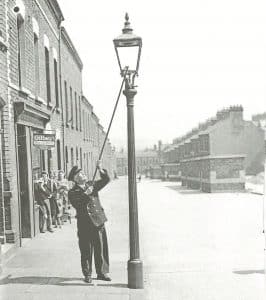Historical Evolution of Outdoor Lamps: From Gas Lamp to LED LampPosted by Ryan Vintage in Solar FAQs.
How Outdoor Streetlights Changed Over the YearsWhat kind of light bulb do you usually see for outdoor Lamps? An Old-fashioned incandescent lamp? Fluorescent light? Or LED lights? You can read the full history of outdoor lighting in the USA here. Gas LampGas lighting was developed in England in 1790 and introduced to the United States by William Murdoch. The first place in America to use gas lighting was Pelham Street in Newport, Rhode Island. It was not long before gas fuel was used for street lighting in major, eastern American cities, such as Philadelphia and Baltimore. Various types of gas fuel include methane, acetylene, butane, propane, hydrogen, and natural gas. Gas lamps are one of the symbols of the Age of Steam, but as people began to enter the age of electricity in the 19th century, gas lamps gradually faded out of fashion. Incandescent LampThe story of the electric lamp begins in 1802 when an Englishman named Humphrey Davy invented the first “arc light”. His lamp produced illumination by creating a blinding electric spark between two charcoal rods. However, this lamp was impractical for daily use: on the one hand, the light was too bright; on the other hand, it could not stably produce light for a long time. However, the principles behind Davy’s arc light contributed to the development of other electric lamps and bulbs introduced in the 19th century. It should be stressed that Edison was never the first or the only person who tried to invent an incandescent lamp. Warren de la Rue, William Sawyer, and Joseph Swan were all devoted to pursuing this goal. Where Edison succeeded and surpassed his competitors was in developing an inexpensive and long-lasting light bulb that has practical significance. Standard incandescent lamps are commonly used in traffic lights, although they are increasingly being replaced by other advanced lamps. Fluorescent LampThe revolution of outdoor lighting never stopped. To improve the efficiency of light bulbs, people invented the fluorescent lamp, a low-pressure mercury-vapor gas-discharge lamp that uses fluorescence to produce visible light. The invention of the fluorescent lamp started with Alexandre E. Becquerel, who observed that a substance emitted light when it was placed in a Geissler tube in 1859. This phenomenon is called fluorescence. In 1901, Peter Cooper Hewitt invented and patented the mercury-vapor lamp, which is considered the precursor of the fluorescent lamp. However, using mercury vapor produced a greenish light. Later on, Jacques Risler introduced a fluorescent material to coat the lamp in 1929, which turned the chromatic light into white. A fluorescent lamp is more efficient in converting electricity into light. The typical luminous efficacy of fluorescent lighting systems is 50–100 lumens per watt, several times the efficacy of incandescent bulbs. Therefore, fluorescent lamps are also called energy-saving lamps. Fluorescent lamps for outdoor street lighting were first introduced for commercial use at the 1939 World's Fair. However, the development prospects of fluorescent lamps are not good. They fell out of favor for street lighting because they are 1) large; 2) produce a diffused non-directional light; and 3) are fragile. In addition, some fluorescent lamps are classified as hazardous waste due to the presence of substances such as mercury. Therefore, in some areas, fluorescent street lights have been recalled by the government. LED LampTechnology always leads to progress. An LED lamp is a type of solid-state lighting which uses a semiconductor to convert electricity into light. It is often small in area (less than 1 square millimeter) and emits light in a specific direction, thus reduces the need for reflectors and diffusers that can trap light. So far, the most promising lights for the 21st century are considered to be LEDs. LED lights, the youngest brother of all the lamps we have talked above, are undoubtedly the best lights compared to the aforementioned traditional lamps. They can save six to seven times the energy, cut energy use by more than 80 percent, and can last more than 25 times longer than conventional incandescent lights. At present, LEDs are specially used for solar lights. The combination of the most advanced lamp and the most environment-friendly energy makes solar LED lights the best choice for city’s streetlight construction.
Solar FAQs
|
ArchivesNo Archives Categories
Want More Info? |
LATEST NEWS & ARTICLES
